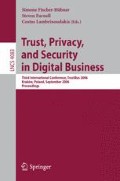Abstract
The contribution of this paper is twofold. On the one hand, we report on the results of our investigation of different categories of usability issues. On the other hand, we introduce the ideas of context descriptive security models as a means of mastering the usability challenges of highly dynamic systems. Modern computer systems are involved in many situations of our daily lives. This means that newly deployed systems must be carefully designed in order to be correctly used by laypersons. The scenario we introduce shows that it is no longer feasible to argue that users must be educated in order to correctly operate these systems. As soon as such a system is deployed, for example, in a supermarket, the education-barrier will not be accepted: neither by the customer nor by the provider.
Access this chapter
Tax calculation will be finalised at checkout
Purchases are for personal use only
Preview
Unable to display preview. Download preview PDF.
References
METRO AG: Metro’s future store initiative (2006), http://www.future-store.org
Dix, A.J., Finlay, J.E., Abowd, G.D., Beale, R.: Human Computer Interaction, 2nd edn. Prentice-Hall, Englewood Cliffs (1998)
CASPIAN: Consumers Against Supermarket Privacy Invasion and Numbering (2006), http://www.nocards.org
Kaiser, J., Reichenbach, M.: Evaluating security tools towards usable security. In: Proceedings of the 17th IFIP World Computer Congress (WCC 2002) (2002)
Markotten, D.G.T.: Benutzbare Sicherheit in informationstechnischen Systemen. PhD thesis, Albert-Ludwigs-University Freiburg (2003)
Whitten, A., Tygar, J.D.: Why Johnny can’t encrypt: A usability evaluation of PGP 5.0. In: 8th USENIX Security Symposium (1999)
Zurko, M.E., Simon, R.T.: User-centered security. In: NSPW 1996: Proceedings of the 1996 workshop on New security paradigms, pp. 27–33. ACM Press, New York (1996)
Flechais, I., Sasse, M.A.: Developing secure and usable software. In: Workshop on Human-Computer Interaction and Security Systems. ACM Press, New York (2003)
Hilty, M., Basin, D., Pretschner, A.: On obligations. In: di Vimercati, S.d.C., Syverson, P.F., Gollmann, D. (eds.) ESORICS 2005. LNCS, vol. 3679, pp. 98–117. Springer, Heidelberg (2005)
DiGioia, P., Dourish, P.: Social navigation as a model for usable security. In: SOUPS 2005: Proceedings of the 2005 Symposium on Usable Privacy and Security, pp. 101–108. ACM Press, New York (2005)
Dourish, P., Redmiles, D.: An approach to usable security based on event monitoring and visualization. In: NSPW 2002: Proceedings of the 2002 Workshop on New Security Paradigms, pp. 75–81. ACM Press, New York (2002)
Sheyner, O., Haines, J., Jha, S., Lippmann, R., Wing, J.M.: Automated generation and analysis of attack graphs. In: SP 2002: Proceedings of the 2002 IEEE Symposium on Security and Privacy, Washington, DC, USA, p. 273. IEEE Computer Society, Los Alamitos (2002)
Dacier, M., Deswarte, Y., Kaâniche, M.: Models and tools for quantitative assessment of operational security. In: Information systems security: facing the information society of the 21st century, pp. 177–186. Chapman & Hall, Ltd., London (1996)
Ammann, P., Wijesekera, D., Kaushik, S.: Scalable, graph-based network vulnerability analysis. In: CCS 2002: Proceedings of the 9th ACM Conference on Computer and Communications Security, pp. 217–224. ACM Press, New York (2002)
Accorsi, R.: On the Relationship of Privacy and Secure Remote Logging in Dynamic Systems. In: Proceedings of the International Information Security Conference Security and Privacy in Dynamic Environments (2006)
Accorsi, R., Hohl, A.: Delegating secure logging in pervasive computing systems. In: Clark, J.A., Paige, R.F., Polack, F.A.C., Brooke, P.J. (eds.) SPC 2006. LNCS, vol. 3934, pp. 58–72. Springer, Heidelberg (2006)
Author information
Authors and Affiliations
Editor information
Editors and Affiliations
Rights and permissions
Copyright information
© 2006 Springer-Verlag Berlin Heidelberg
About this paper
Cite this paper
Höhn, S. (2006). Bringing the User Back into Control: A New Paradigm for Usability in Highly Dynamic Systems. In: Fischer-Hübner, S., Furnell, S., Lambrinoudakis, C. (eds) Trust and Privacy in Digital Business. TrustBus 2006. Lecture Notes in Computer Science, vol 4083. Springer, Berlin, Heidelberg. https://doi.org/10.1007/11824633_12
Download citation
DOI: https://doi.org/10.1007/11824633_12
Publisher Name: Springer, Berlin, Heidelberg
Print ISBN: 978-3-540-37750-4
Online ISBN: 978-3-540-37752-8
eBook Packages: Computer ScienceComputer Science (R0)

